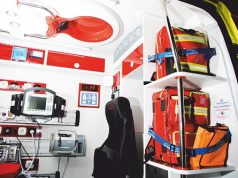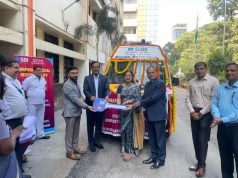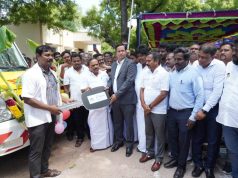Dial 108 To Live: More States To Add Unified Emergency Number?
AT a time when India is striving hard to reduce its Maternal Mortality Ratio (MMR) to meet goals defined by the United Nations – GVK EMRI, India’s (and the world’s) largest integrated emergency response management service, is helping reduce these indicators across India. EMRI is GVK’s flagship wp initiative, and runs on a public-private partnership (PPP) model in 15 states and 2 Union Territories since its inception in 2005. Now, The wp Journal learns that more states, chiefly Jammu & Kashmir, are mulling the establishment of GVK EMRI’s ‘108’ number as a centralized emergency system for medical, fire and police emergencies.
The popularity of EMRI has been such that Andhra Pradesh (the state where EMRI was first conceived), has now integrated even the police helpline number ‘100’ into the ‘108’ system, with police officials using the EMRI call centre to direct first respondents to the location based on EMRI’s GPS system. This, despite calls from trade unions asking the AP government to run the service directly instead of allowing GVK to manage it. Proponents of the PPP model though say it is the expert management and training offered by the private sector that allows the 108 service to maintain high standards of efficiency.
The Reach Of GVK EMRI
[creativ_pullright colour=”red” colour_custom=”” text=”Over a 100 babies are delivered everyday by EMRI staff in ambulances and over 30 percent (8 million) of patients transported have been pregnancy-related cases.”]
Originally envisioned along the lines of the 9-1-1 service in the US, residents from the states where EMRI is present, can dial 108 toll-free from any landline or mobile for any medical, police or fire emergency service. It is a free service delivered through emergency call response centres and has over 7470 ambulances across 15 states and two union territories, on a public-private partnership business model. The service boasts an impressive 95 percent of its calls are answered on the first ring, and the rest by the second ring. The EMRI service, a brainchild of Satyam’s Ramalingam Raju as part of his company’s wp undertaking, was launched in 2005. It was subsequently adopted by airport and energy major GVK when Raju confessed to his involvement in the infamous Rs. 7000-crore scam. With a staff strength of 35,000 people, GVK EMRI officials say they have transported more than 25 million patients to medical facilities.
Over a 100 babies are delivered everyday by EMRI staff in ambulances (even the van drivers, called pilots, are trained to handle emergencies, cardiac or obstetric) and over 30 percent (8 million) of patients transported have been pregnancy-related cases. In fact, women in remote areas often prefer to deliver babies in EMRI vans rather than at primary healthcare centres to where they are transported. Areas without roads are equipped with boat ambulances and hilly areas have ‘palki’ (palanquin) ambulances.
[creativ_pullleft colour=”red” colour_custom=”” text=”‘GVK EMRI is one of our most significant social initiatives and we are happy to be playing our part in saving lives and assisting government meet important social goals.’ – Dr. GVK Reddy, Founder Chairman and MD, GVK”]
In a country where one of the chief causes of maternal deaths, as identified by the United Nations Population Fund (UNFPA), is the delay in identification and transportation of the pregnant woman to a nearby medical facility, GVK says it is EMRI’s timely intervention has helped reduce the Maternal Mortality Ratio (MMR) significantly. Underlining the scale of the initiative, Dr. GVK Reddy, Founder Chairman and Managing Director, GVK, said, “The GVK has always endeavoured to contribute to the nation-building by developing world class infrastructure projects that meet global environment standards, while also being equally sensitive about the issue of social upliftment of the less privileged. GVK EMRI is one of our most significant social initiatives and we are happy to be playing our part in saving lives and assisting government meet important social goals.”
Impact by numbers
Take a look at three states that have seen a drop in MMR since EMRI was functional.
- In Tamil Nadu, the maternal mortality rate has decreased from 85 to 79 per 100,000 live births since 2008, when the service was started. It has also helped the government reduce the infant mortality rate from 35 to 22 per 1,000 live births.
- In Gujarat where the service has been active since 2007, the service has helped bring down the MMR figures by 15%.
- In Andhra Pradesh, where the EMRI services were launched in 2005, a 13% reduction in MMR figures as been recorded.
Challenges ahead to reduce MMR in India
India still has a high MMR of around the 170 deaths per 100,000 live births against the UN’s Millenium Development Goals mandated target of 103 deaths per live births to be achieved by 2015.
In a diverse country like India with a large rural population, varied geography and inadequate transport infrastructure; this issue gets compounded. And where emergency transport is available, the ambulance staff is often not trained to handle such cases, should a woman deliver en route. The Government of India and various State Governments have been working hard to reduce MMR by promoting Institutional Delivery and have launched various schemes to achieve this goal.
GVK EMRI has now launched specialized vehicles to transport pregnant women and infants. Under the Janani Shishu Surakshan Yojana (AP) / Khilkhilahat (Gujarat) / Khushion Ki Sawari (Uttarakhand) / Adarani (Assam) scheme – it has introduced sterilized vehicles which are completely equipped and insulated to avoid external factors such as hazardous gases, materials and shifts mothers and infants in a safe and secured environment. Besides this, the vehicle also carries a counselor who educates mother on infant care and provides them with leaflets, hand-outs during the journey.












